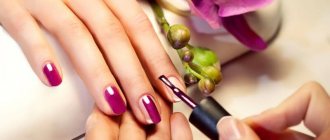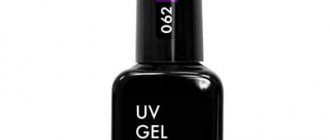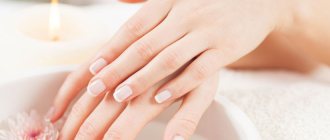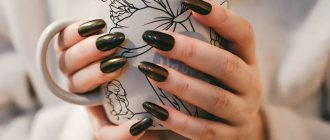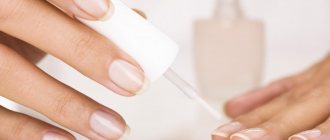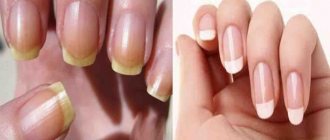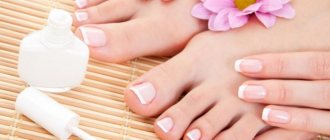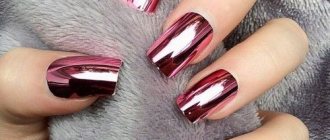Hands are a calling card for any girl.
An ideal manicure will speak of its owner as a neat and well-groomed person. Many girls are concerned about the slow growth of nails , which makes it impossible to get a beautiful manicure.
However, in this case, nail care products at home , which significantly accelerate their growth.
Aesthetic beauty of long nails
Neat long nails are, first of all, aesthetically beautiful. Short nails are more relevant for the stronger half of humanity, while girls should stand out with long nails.
Beautiful long nails are relevant and necessary for girls in such professions, for example, as a consultant in a jewelry salon, models and fashion models, and beauty salon technicians.
When working in such areas, beautiful long nails with a perfect manicure are essential.
Nail growth rate
| On average, the rate of nail growth for all people is approximately the same. On average, nails lengthen by 3 millimeters . It takes 3 to 6 months fingernail to be completely renewed . A person's toenails renew in 12-18 months , which is three times slower than the growth of fingernails. |
There are studies that show that nails grow faster on the working hand.
The speed of nail growth is also affected by the time of year - it has been found that nails grow a little faster in summer than in winter. There is still no clear answer to what this is connected with. It is believed that in summer the hands are more mobile, which indirectly affects the growth of nails - according to the site.
The longest nail was recorded in a woman and was 601 mm.
But due to individual characteristics, metabolic disorders and various diseases, nails become brittle and fragile. This is the main reason for the problem of short nails.
As you age, nails begin to grow more slowly. This is due to the fact that the older a person is, the less actively all his structures work, including the production of keratin, the base of nails.
In children, the rate of nail growth is approximately one and a half times greater than in adults. This growth of nails continues until puberty - source
Also, nail growth slows down when there is a lack of sufficient amounts of protein, vitamins and microelements in the body.
In a young and completely healthy body, the following factors can cause a change in the rate of growth of the nail plate:
- pregnancy (nails may grow faster or slower than usual);
- period of lactation and breastfeeding;
- regularly washing dishes with detergents without using protective gloves (slows down nail growth);
- active adherence to any diet;
Also, regular use of shellac and nail extensions significantly slow down the growth of nails, due to insufficient oxygen supply to the nail plate.
Unlike the popular belief that nails grow after a person’s death, this is not true. Drying of the skin on the fingers creates the appearance of nail growth.
How does the nail growth process occur?
Nails are keratinized tissues formed in the form of a plate. Located on the back of the ends of the fingers both the upper and lower extremities, most primates have them.
The function performed by the nail plate is to protect the ends of the phalanges of the fingers. This arrangement is caused by the need to protect soft tissues and nerve endings located among them from damage. These protection products are made of a protein called keratin. Such explanations are given by encyclopedias.
Keratin is the main building element not only of the nail plate, but also of hair.
If you believe Darwin's theory, then our ancestors are monkeys. In these primates, protective plates at the ends of the fingers can serve for defense and climbing trees. They're almost like claws.
The nail plate does not have blood vessels or nerve endings, therefore, this tissue is non-living. But at the same time it can grow. The plate is made from more than a hundred keratinized plates by layering one on top of the other.
The semicircle at the base of the nail is called a lunula. It is here that the cells that produce carotene are located, that is, they form new fragments of the plate. The location of the lunula is clearly visible in the photo:
In a lunula, new produced tissue is added to an existing part. At the same time, the nail is pushed forward - it grows. There is a narrow area of skin above the lunula. It is called the cuticle. This protects the lunula and the base of the plate from bacteria entering them, as well as from mechanical impact.
With age, the growth process of the plate slows down. Often during this period, all sorts of patterns, dots, lines or dents begin to appear on or under the nail. The reasons for this manifestation lie in the body, which thereby signals internal problems. It is the plate that first begins to show its owner that he has some kind of disease.
Biologically, the growth process of fingernails and toenails is no different. There is a difference in the speed of their regrowth.
A very interesting illustration, in it the growth zone is called not a lucula, but a hole, which is also acceptable:
This is how nails grow. Click on the picture to enlarge!
This video will help you figure out the issue; it also gives recommendations for accelerating growth:
How a nail grows: structural features of the plate and renewal process
The nail plate is an important element of a girl’s body, since it protects the nerve endings located in the fingertips from damage. When the coating becomes thinner or completely destroyed, the area becomes vulnerable to external factors, which affects the general health of the woman.
The nail consists of three main parts:
- The matrix is the root of the nail. The invisible part, from which the base and development of the plate begins, the health of the manicure and its integrity depend on its condition.
- Cuticle. The part of the skin that separates the outer and inner parts of the nail plate. It often grows on the coating, which is why you need to pay attention to proper care.
- Nail bed. The main surface, including the lunula and the free edge, which receives the most attention when performing a manicure.
You should also pay attention to the side ridges located on the sides of the nail, as they support the protective function of the nail, preventing pathogenic bacteria from entering under the surface.
As the plate grows, its structural features depend on the health of the matrix. Even with a slight deformation of the base, the risk of damage to the natural bed increases, detachments and yellowness occur, and local immunity decreases.
How to speed up nail growth using home methods
By speeding up the process of cell division in the matrix, you can speed up the growth of the plates. You shouldn't expect magic, but good results can be obtained from the following procedures:
- Daily massage of the fingertips and matrix with soft circular movements or with the index and middle finger of the other hand closed in a lock.
Hand massage: types, technique, recommendations for the procedure - Taking vitamins and minerals for growth will speed up the process a little and make the plates less brittle.
As a result, there will be a faster growth effect, so the ends will not flake and break off. Vitamins for nails - which ones are needed and how they affect - Application of special varnishes and serums to accelerate growth.
Particular attention should be paid to the matrix zone, since this is where cell division occurs. How to use IBX System, all features of the product line - Protect the tips during any household work and physical activity so that they do not simply grind off on hard objects.
- Oil and water based baths with the addition of any components that improve blood circulation in the growth area.
For example, citrus oils, rosemary and tea tree. Hand baths: 30 recipes for different purposes - Capsules with an oily solution of vitamins A and E. You can directly rub the composition into the matrix area 2 times a week for 5-7 weeks under plastic gloves for 30 minutes.
How to care for your nail after removal
Regardless of the removal method, it is imperative to take care of the remaining wound. This is necessary to prevent inflammatory processes and relapse of infection. Immediately after removal, the surface is disinfected again, healing and antifungal ointments are applied under a gauze bandage. Then treatment is prescribed for both external use and oral administration.
- do the dressing every day until the wound heals;
- keep the dressing sterile and dry. If it gets wet or dirty, replace it immediately;
- in the first days, strict bed rest is prescribed;
- do not put weight on the affected leg while walking;
- During rehabilitation, try not to wear shoes, wear clean socks made of well-ventilated, natural fabric.
If swelling or suppuration appears on the bed, you should urgently consult your doctor. A healthy nail does not grow as quickly as we would like. After two to three weeks, the wound will heal, and you can loosen the strict supervision a little and get prosthetics. On average, a nail grows 3 mm per month. Due to the physiological characteristics of the body, this process occurs more slowly on the legs than on the arms. Thus, the plate will grow back completely no earlier than in six months.
What determines nail growth factors and causes
There are many factors that determine how quickly a girl’s nail grows, regardless of the initial state of the plate.
Keep in mind that it is impossible to provoke a strong acceleration of surface regrowth, since it is determined by the genetic characteristics of the body, however, a girl can slightly increase local immunity by strengthening her manicure.
Several main factors affect the growth rate of coverage:
- Processing quality. Even when performing a manicure or pedicure in a salon, there is a risk of improper processing, which damages the stratum corneum and deforms the surface, which reduces the rate of its recovery.
- Diet. A lack of vitamins and microelements in the body, or vice versa – excess fat, can lead to damage to the matrix.
- Exposure to aggressive components and compounds. If you neglect to wear protective gloves when working with detergents and chemicals, their components penetrate into the structure of the plate and gradually destroy it, inhibiting growth.
- Water balance. Regardless of the time of year, you always need to maintain the water balance of the body and the nail plate. With a lack of moisture, the stratum corneum begins to separate, which reduces the efficiency of growth and the integrity of the coating.
- Wearing decorative covering or nail extensions. Nowadays, girls rarely leave their nails in their natural state, however, long-term continuous application of dense compounds on the surface limits the access of oxygen, which reduces local immunity.
- Compliance with personal hygiene rules.
Internal problems associated with the presence of pathologies, diseases or inflammatory processes in the body always affect the quality of hair, teeth, nails and skin. If you have such symptoms, be sure to perform diagnostics to find out the cause of the defect and eliminate it.
Additionally, the sensitive area needs to be cared for daily. To do this, use folk recipes (steam baths, compresses, lotions) to strengthen the surface, nourish it with useful microelements and vitamins.
Nail prosthetics
After removing the nail plate, an unsightly crust remains. Women who are more demanding in matters of aesthetics suffer especially. The feeling of security in the legs disappears, which negatively affects the psychological state. Great discomfort is felt when walking.
To restore comfort during rehabilitation, you can use nail prosthetics - install an artificial plate made of acrylic or gel.
You cannot do prosthetics right away: it is necessary for the wound to close and a crust to form. There should be no inflammatory processes, suppuration, psoriasis or other problems. An artificial nail is placed only on a clean, healthy surface. Before the procedure, it is necessary to disinfect not only the feet, but also the instruments used.
- Gevol is a polymer mass that is placed in an empty bed. A nail is formed from it, and after hardening the plate is adjusted to its shape.
- Unigzan - suitable only in cases where part of the natural nail plate remains (at least 3 mm).
- Glue and canoline. Treatment will require a complex system of alternate application of glue and polymer composition. But the material is breathable, and the plate is thin.
- Acrylate - used to smooth the growth of healthy natural nails.
Do not confuse prosthetics and extensions. The procedure itself is similar, but the polymers used have different compositions. Plasticizers introduced into the prosthesis make the artificial nail flexible and durable. And special components treat fungus and protect against re-infection. Dentures are not suitable as the main antifungal agent. But they manage to prevent and maintain healthy feet.
Anatomy of Human Nails – information:
The nail is a horny formation (horny plate), similar in origin to the outer layer of skin and hair, as well as to the claws and hooves of animals. Nails are located in the nail bed, where nail growth occurs. In adults, the average length of nails is 1.5 cm, thickness is 0.75 mm on the hands and 1 mm on the feet. The nail is divided into a root, which is located in the nail fissure, a body and a free edge, which protrudes beyond the boundaries of the nail bed. The nail root, hidden under the skin, makes up 30% of the total length of the nail.
The nail bed contains a large number of blood vessels that nourish it and create its healthy pink color. The folds of skin that border the nail at the side of the root and at the back are called ridges. Nail growth begins with a matrix, the continuation of which is a white, crescent-shaped formation - the lunula.
In the nail matrix, keratinocytes (one of the types of skin cells) thicken and become smooth and flat, thus promoting the formation of the nail plate. The cuticle firmly connects the skin fold of the nail with the nail plate at the base of the nail and the nail plate with the nail bed in the area of the free edge of the nail. The cuticle protects the nail bed and matrix from any infection. Nails are a hard shell to protect the delicate fingertips, with which we grasp various objects and physically feel the bodies around us. Nails allow us to pick up something; if the object is small, then without such hard formations it is difficult to grasp it at all. In addition, everyone is obviously aware of the possibilities of scratching or scratching of nails.
In Central Asia and Persia it was believed that the soul was in the nails. Therefore, cut nails were buried in the ground and burned so that they would not fall into the hands of witches and would not be used for conspiracies and witchcraft. There were a number of customs when it was generally forbidden to trim nails at certain times of the year, month, or week. For example, the ancient Slavs imposed restrictions on shepherds - not to cut hair and nails, not even to make love while shepherding, observing chastity.
It is known that the total length of nails trimmed over a lifetime in men reaches 3.9 m, and in women - 4.3 m. Nails grow at a rate of 0.15 mm per day, depending on the age and state of health of the person. It is not difficult to calculate that nails on the hands are renewed every three months, and on the feet - every 4.5 months. Consequently, in a year a person changes only 65 nails, and over the course of a lifetime, a man changes 4,700 nails, and a woman. - 5200.
With a daily growth of 0.15 mm, nails will grow by 4.5 mm in a month, and by 5.4 cm in a year. Nails grow worse during pregnancy and recovery from any damage. In addition, the nails on the right hand (and, for a left-handed person, on the left) grow faster. This is obviously related to the frequency of using your hands. The fetus's nails grow to the fingertips only towards the end of the mother's pregnancy, so their length is used to judge whether the fetus is full-term. In adults, nails grow quickly, but in old age, nail growth slows down. Nails grow faster on long fingers (middle, ring, index), and growth occurs more intensively during the day compared to night, in the morning compared to the second half of the day, and also in the warm season compared to the cold. In addition, the growth rate of fingernails is half as fast as that of toenails.
For a person who would refuse to cut his nails, their growth would still not become endless, since nails, having reached a certain length, stop growing. The Guinness Book of Records records record long nails: measuring 5 nails of the left hand of Sridhar Chillal from India at the end of March 1997 showed that their total length was 6.12 m. At the same time, the thumbnail accounted for 1.40 m, index nail - 1.09, middle - 1.17, ring finger - 1.28, little finger - 1.22 m. The last time Chillal cut his nails was in 1952.
The shape of the nail varies. Obviously, not without reason, L.N. Tolstoy endowed the elegant Missy Korchagina with a wide nail (on her thumb), reminiscent of the same nail of her father, a cruel and very unpleasant man. In those days they did not yet know, but now it has already been precisely established that the shape of the nails is connected both with the hormonal activity of the body and with the structure of the final phalanx of the fingers, as well as with whether the owner is engaged in physical labor or not. In addition to gender, the shape of nails is also influenced by the predominance of the side of the body (right-handed or left-handed) and the diseases the person has suffered.
In the Ancient East it was believed that each nail was directly related to some organ. For example, the thumb is connected to the brain, the index finger is responsible for the functions of the lungs and respiratory system, the middle finger reflects the condition of the intestines, the ring finger talks about the kidneys, and the little finger gives an idea of problems in the heart and cardiovascular system as a whole.
The state of health is indicated not only by the shape and structure of the nails, but also by the color of the nails . Pink, shiny, smooth nails that perfectly match the shape of your finger are a sign of absolute health. In those suffering from heart disease, they are unnaturally pale or bluish. If only the nail hole turns pale, this is a sign of anemia. But whitish, so-called opal-colored nails indicate serious liver problems. Yellow nails also indicate problems with the liver. However, it is possible that their owner (or owner) smokes, or works with chemicals, or uses low-quality acetone-based nail polish remover. Nails can also react to certain medications. For example, after long-term treatment with antibiotics, yellow-brown stains are often visible on them. Nails can become dark brown as a result of X-ray exposure of the fingers, or due to Addison's disease. With diabetic thrombosis of the arteries of the upper extremities, the nails may take on a mournful black tint. Damage to the nail bed caused by pyogenic bacteria, usually penetrating through hangnails, is called paronychia . The disease can be treated with antifungal ointments. The effect of treatment is enhanced by a balanced intake of vitamins and minerals. Patients with diabetes, as well as those suffering from diseases caused by a deficiency of a number of minerals, people whose hands often come into contact with water: dishwashers, bartenders, nurses are predisposed to paronychia. To avoid this problem, always use rubber gloves when washing dishes. Thin, spoon-shaped (concave) nails, especially on the big toe, indicate a lack of zinc and iron in the diet. Because of this, they often become brittle and pale. Getting iron into the body will help cope with iron deficiency anemia and improve overall health, including nails. Valuable sources of iron are red meat (lamb and beef), fish, poultry, and green leafy vegetables. Since vitamin C helps in the absorption of iron found in plant foods, try drinking fruit juices with meals instead of strong tea, as the tannin present in it interferes with the absorption of iron.
Brittle, brittle nails and frequent infections of the skin around them usually indicate a lack of zinc in the diet. Eat foods rich in zinc - seafood, eggs, meat, nuts, legumes. A deficiency of selenium can lead to the appearance of wide ridges or scars on the surface of the nails, and an excess can lead to their blackening. Seafood is rich in selenium, as well as brewer's yeast, bread and cereal products. Many people believe that calcium-rich foods will make their nails strong and healthy. In fact, this chemical element plays far from the main role in strengthening nails. The appearance of small white spots on the nails, which was previously attributed to calcium deficiency, is now considered to be the result of a bruise, excessive manicure or, in rare cases, the result of a lack of zinc in the body.
Nails with kidney disease are striped, covered with white and brown transverse stripes. Medicines containing silver, arsenic, mercury, phenolphthalein, iron, as well as antimalarial drugs and tetracycline antibiotics can also color the nails of patients in different colors. Like hair loss, brittle nails are the first sign of a malfunction of the thyroid gland, and in some cases, an indicator of disturbances in the menstrual cycle and ovarian function. In case of pulmonary diseases, including chronic ones, the central part of the nail is convex; in case of anemia, the opposite is true. If numerous pinpoint depressions appear on its surface, it is possible that this is the initial stage of psoriasis. Infectious diseases such as measles, jaundice, rubella can leave imprints in the form of transverse grooves not only on the skin, but also on the nails. They are usually localized on the thumb, index or middle fingers.
Longitudinal grooves indicate difficulties with the intestines or pancreas. The shape of the nail plate can also be used to judge a person’s character. There is even an ancient fortune telling by nails - onychomancy . Long nails are attributed to people who are thoughtful, slow, and distrustful, while short nails are attributed to people who are logical, prone to control and criticism. The shortest are supposedly among the hot-tempered and irreconcilable. Some people carefully grow them for prestige. Others, usually easily excitable and unbalanced, on the contrary, bite. Thus, those with short nails occupy leadership positions and are prone to leadership. They are distinguished by self-confidence, a methodical approach to all life situations, and absolute argumentation of their point of view in disputes. At the same time, they are accustomed to conflicts in the family, with friends and at work. Those whose nail plates are wide and very short are uncooperative and tend to be lonely. They do not shine with a sharp mind, but are very persistent and hardworking. Wide nail plates of medium length show that we have kind, gentle and sentimental personalities. Their career growth is not very successful, but their team loves them.
Curled, hooked nails indicate that a person is tight-fisted, even greedy. He is too economical not only in relation to himself, but also to his family, meticulous and efficient, which helps him occupy positions close to management. The Ural Cossacks, according to Dahl, suspected Pushkin of the Antichrist, because they could “see” claws on his fingers instead of nails. In humans, indeed, the nail has replaced such a weapon as a claw. Another thing is that the great poet actually had an extravagant horny growth (long nail) on his little finger and protected this distinctive sign of a Mason with a special case. Shovel-shaped, strong nails indicate that their owner’s mind and logic clearly prevail over emotions. Such a person is a born materialist who prefers practical knowledge about life to any intuitive guesses.
Any work that he undertakes or makes his life’s work will be honed to the smallest detail, to perfection. Angular or quadrangular shape of nails is a sign of a person prone to philosophical thinking. And not only in the field of art, literature and other humanities. The sphere of exact numbers and calculations may also be available to him. The most important thing is that such a person unmistakably sees harmonious logical connections in everything, precise and natural. A similar shape of nails can also speak of a powerful person, capable of being a leader, rising above the crowd, and being the first to make the only right decision in an extreme situation. However, his weak point is his own inner world. A person with square-shaped nails is simply lost when it comes to tracking his feelings, emotions, complexes, and motives for his actions. At the same time, he perfectly “sorts out” the internal self of another person and never makes a mistake, but as soon as it comes to himself, the unmistakable and cold logic fails. A pointed or conical shape of a nail may indicate the owner’s penchant for painting, architecture, sculpting and other plastic arts. These are artistic natures, natural romantics, dreamers, accustomed to somewhat embellish reality, and therefore - optimists who see the light through rose-colored glasses. They can easily get carried away by a business, person or idea, but it is also easy to cool down and switch to something more interesting and new. Especially if their previous hobby requires perseverance and focused effort. In other words, such a person is captivated by what “comes to hand” and does not require perseverance, perseverance, or patience. Another feature is independence both in the sphere of personal and social relations. Material goods leave them completely indifferent. This, of course, is not asceticism, but these benefits are perceived rather as a given, and not as an end in itself in life. According to the pre-Islamic ideas of the farmers of the Western Pamirs, Adam and Eve in paradise had their entire bodies covered with a hard substance like nails. It replaced clothes. After expulsion from paradise, this cover disappeared, remaining only on the fingers and toes. The first people had to cover themselves with fig leaves. And since then they have treasured nails, because they are the ones that never left a person, and even came from paradise. In Ancient Rus', pieces of nails carefully preserved during life were placed in a coffin after the death of their owner; they believed that they would grow and help him climb up.
The Egyptians (you can see this on mummies) came up with the custom of painting their nails red in order to once again imitate life with the help of magical signs of blood. Buddha's were supposedly copper-colored. There are many shades, as well as colorful comparisons. Nowadays, experienced masters are engaged in downright artistic painting of nails, depicting on them not only complex ornaments, but also political figures, mythical animals, etc. If you don’t want to paint them at all, you can use plastic or very expensive ones made of gold and platinum. The method, it turns out, is not so new. The deceased Tutankhamun's toes were covered with gold cases with images on them of not only nails, but also the first joints. To create a perfect looking nail, use the following guidelines for shaping it. Examine the nail from each of the seven angles: left and right, tip down, tip up, angled, straight, palm side. All nails should be of equal length and consistent with the shape of the fingers. From the side you should see a small “dome” of the nail. This shape, in addition to beauty, also gives strength to the nail.
